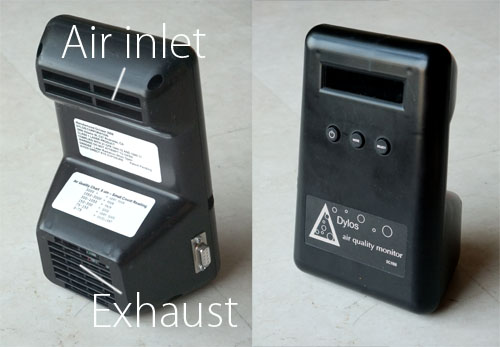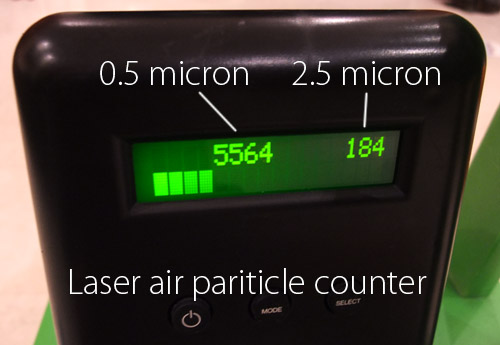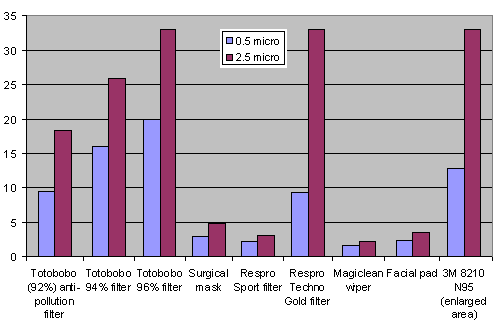The filter is the most important component of a respirator. The quality of air that gets into your lung is determined by the quality of the filter, provided there is a good seal between the mask and your face.
The design of Totobobo mask makes it quite easy to replace the filter with any flat, air permeable material. It is tempting to use a “filter look-a-like” such as cotton wool or a piece of felt to replace the used filters. Does it work? I am interested to find out how effective these different alternatives are.
A Dylos laser particle counter is used to collect objective data. The particle counter is affordable and performs consistently. I’m using the Pro version which is able to detect two fine particle sizes: 0.5 and 2.5 microns. The particle counter has an air-inlet and a exhaust vent. Air drawn into the counter goes through a passage and there is a laser diode and an optical counter along the air passage. If the air inlet is covered by a piece of filter, air drawn into the unit will be filtered and therefore produce a lower particle count reading. The performance of the filter can be calculated by dividing the ambient particle count value with the “filtered” value. For example, if the particle count drops to half, the protection factor of that particular filter is 2.

Dylos Laser Particle Counter
The method is simple and easy to understand. First of all the ambient particle counts is measured against two different particle sizes – 0.5 microns and 2.5 microns. Different types of “filters” are used to cover the air inlet (edge seal with tapes) one after another. Reading of each filter is obtained after 2 minutes when the value stabilized. Finally, the ambient particle count is once again measured without any filters. The first reading without the filter and the last reading are within 5% tolerance.

Laser Particle Counter reading without filter
Protection factor (P) of each filter is calculated by the formula:
P = Qi / Qn
Where Qi is the value of ambient particle count without filters and Qn is the particle count of the filter concerned. Higher P value indicates better protection factor.
The Totobobo filter (low cost anti-pollution filter) produces a high protection factor of 5564/587 = 9.5 (for 0.5 microns) and 184/10 = 18.4 (for 2.5 microns). This figure indicates a high filtration efficiency of over 90%, effectively raise air quality from “VERY POOR” to “FAIR”.

test reading of Totobobo filter
Surgical mask is commonly used, the problem is getting a good seal. In this test, we seal the surgical mask filter media over the inlet to measure the filter effectiveness. As expected the protection value is not very high: P=2.9 for 0.5 microns, P=4.8 for 2.5 microns.

test reading of surgical mask filter
As a reference, the filter of a Respro City mask is also tested. The result is disappointingly poor: P=2.2 for 0.5 microns, P=3.1 for 2.5 microns. I am shocked since this product was reported some years ago to be among the “top performers”. I checked several times to make sure the readings are correct. It may be possible that my sample is dated (over a year old). I will update this record if new evident is found to prove this results wrong.

test reading of City mask filter
Magiclean is cheap and commonly available and it’s working principle is based on static charge in the fibre, a characteristic of Totobobo filter. I expect it shell produce reasonable good performance. However, the result of 4 layers of Magiclean wiper is the worst out of the lot: P= 1.6 for 0.5 microns, P=2.2 for 2.5 microns.

test reading of Magiclean dry wiper sheet
Facial pad is probably the most commonly used “replacement filter” since some of them available in similar dimension as Totobobo filter. The result of the test is: P=2.4 for 0.5 micron, P=3.5 for 2.5 micron. This is slightly better than the result from the Respro filter.

test reading of Facial pads
Finally a benchmark test was performed against the well know 3M 8210 N95 filter. However, as the air resistance is too high, we need to enlarge the total surface area and we manage to seal the enlarged area around the inlet. The performance of this filter is remarkable: P=12.8 for 0.5 micron, P=33 for 2.5 micron, highest of the lot. The only problem with this material is the air flow resistant. It is more difficult to breathe through.
Protection factor (higher better)
| Filter _________ Totobobo anti-pollution filter Totobobo 94% filter Totobobo 96% filter Surgical mask Respro City filter Respro Techno Gold filter Magiclean wiper Facial pad 3M 8210 N95 (enlarged area) |
0.5 micro _________ 9.5 16 20 2.9 2.2 9.3 1.6 2.4 12.8 |
2.5 micro _________ 18.4 26 33 4.8 3.1 33 2.2 3.5 33 |
Note: these tests are intended to compare relative protection factors between different filters. These test results are not calibrated to various manufacturer’s standard or NIOSH.
Conclusion:
3M 8210 N95 and Totobobo are the only two filters provide real protection factor above 9.5. These results is consistent with the finding of a study done in the Chinese University of Hong Kong (Prince of Wales Hospital). However, the air resistance of the 3M 8210 filter is too high and is not suitable to be used with Totobobo mask.
All other alternative filters are considerably less protective.
Update:
I managed to get my hands on a new Respro Techno Gold filter and tested it with the laser particle counter. The result is much more promising than the Sport filter. In addition, I also tested the Totobobo 94% and 96% filter to complete the picture. The 94% is the 2nd best performer for 0.5 micron and slightly less protective than the 3M 8210 filter for 2.5 microns. The Totobobo 96% is the best filter so far. Added a chart for easy comparison.
read more :
Cyclist, protect your lung when riding in the city
How to change Totobobo filter?

Hi,
Tanks a lot for a very useful article !
Just one question, I look at Respro´s homepage. They claim that : “The filter material in the Sportsta mask is subject to testing which gives 99% filtration of particulates smaller than PM2.5 (2.5 microns); in fact almost ten times smaller, 0.3 microns”.
Is the Sprortsta filter comparable to one you tested. In that case I am confused about what Respro say, since it should come much better out on your testing..? Or have I misunderstood sometthing here ?
Best regards
Terje Sprenger
Oslo
Hi Terje,
Thanks for your comment.
During the test we had the Respro City mask at hand and that was what we’ve tested:
http://respro.com/store/product/city-mask
Just checking the Respro site, this particular model (City Mask) is suitable to filter out PM10, not PM 2.5 or smaller. That could be the reason of the poor performance. This information was not clear during the time of the test in 2010. There are many types of filters offer by Respro. Some of them can reach N99.
BTW, 3 years later in 2013, a Dutch TV program tested Respro mask and the result is inline with our test in 2010:
https://www.youtube.com/watch?v=QUf1tKnv0qA
In the video
@2:05 ambient air PM is 50 mg/m3
@2:31 filtered air in the mask is 20 mg/m3
This is a ratio of 2.5 and our result was 2.2.
Did you test RZ Mask filters? (contains activated carbon) I wonder if what is given producer on its effectiveness is true
Did you test Respro’s Sportsa or City filter? The two are different (the latter contains activated carbon) and you seem to refer to both. I use a City filter and its shape is differnet from the one pictured above. Your results are really shocking and suggest that the Respro filter is a ripoff. Thank you.
We tested the filter came with the Respro City Mask. I believe it is the one with activated charcoal filter.
How does intense demand affect the effectiveness? Used “I can breathe ” masks for a few months.
They do not seal. Did notice some help.Yet wonder about the carbon monoxide filtration claims.
Typically the bicycling being done here is demanding huge volumes of air especially during sprints and sustained race levels of activity. How does the Totobobo work under these conditions.
ALso, is there any evidence of breakdown under extreme humidity? Central Floridian summers and the rains are coming . Still searching for access/ merchants of this filter, too.
Thanks very much for the filtration comparisons.
TR
Carbon monoxide requires very special filters. We don’t have this type of filter in our range.
Totobobo filter, like most electrostatic charged filters, will be affected by moisture. For heavy exercise we recommend the SuperCool (mouth) mask, which helps to reduce moisture level inside the mask.
Hope this help.
Totobobo filter will not ‘clogged’ for typical use. It’s effectiveness of filtering fine particles degrade as more and more particles are attracted to the fibers and ‘neutralize’ the electro-static charges. More information of the working principle can be found here: http://totobobo.com/blog/does-smaller-particle-always-penetrate-filters-easier/
How about a test for filter quality over time? leave the Dylos on for a week or two, and check the reading once a day. If the Dylos can also measure the air resistance, take down that measure as well. So can create a graph of air resistance and filtration score over time, for 3M material and your material. This will say how quickly each material gets ‘clogged’–how often it needs to be replaced.
Best.
The fan on the Dylos monitor isn’t strong. A lot of the particle count reduction could simply be because the fan was unable to pull as much air through the detector — you measured air flow reduction instead of filtering.
Pascal, thanks for your comment.
To measure the impact of reduced air flow, we did a simple experiment by blocking 7/8 of the air inlet to reduce the air flow, and the reading of the particle count stays similar. I anticipate the counter counts the “dynamic density” of the particles. Higher speed particle means shorter exposure time and that actually reduce the reading. However, the effect is neutralized by the bigger volume of air passing through the counter. We also waited longer time if the air flow reduces, to make sure there is enough time to replace all the air inside the counter.
What do you think?
Wow, this is very useful. Many companies offer pollution mask and filters, but none bold enough to do such a test.
Dude, that’s a great post. Can you try some other material, such as T-shirt, tissue paper or even sponge?